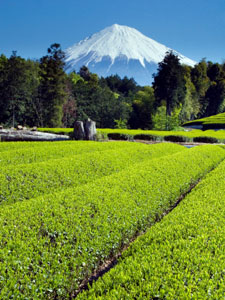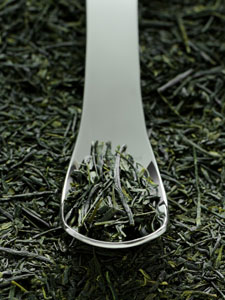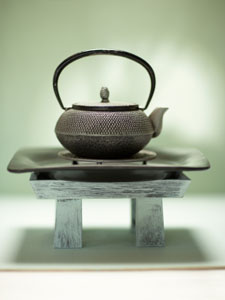Japanese Tea



Over the course of millennia, the Japanese have refined tea to a level of artistry and spiritual importance, epitomized by Chado, "the way of tea." The nation's culture of devotion and discipline have created strong traditions and elaborate rituals in celebration of the drink.
History
As far back as the 8th century, there is written record of monks drinking tea in Japan to aid in meditation. It wasn't until Eisai, founder of the Rinzai sect of Zen Buddhism returned from a pilgrimage to China in 1191 with tea seeds that a culture launched around its consumption. At the time in China, tea was primarily white and served in powdered form, as was customary during the Song Dynasty. To this day, Japan continues the tradition with matcha, a powdered green tea — the focal point of tea ceremony.
In 1211, Eisai published Kissa Yōjōki "How to Stay Healthy By Drinking Tea," the first text of its kind in Japan. Once reserved for religious rites, nobility, and the warrior class, tea was becoming a popular beverage. In commemoration of Chado, and with generations of austere values passed on from Rinzai Zen followers, Sen No Rikyu (Grand Tea Master to two successive emperors) codified Chanoyu, the Japanese tea ceremony, in the mid 16th century.
From 1641 to 1853, Japan was completely closed to trade and China secured a monopoly on the world tea market. During this time, Japan refocused its attention towards domestic production. In 1738, Soen Nagatani created a method for steam-pressing tea leaves, leading to the creation of a green tea style called Sencha.
With the end of isolation in the mid 19th century, tea producers embraced industrialization and, for the first time, black teas. There was a bubble after World War I, before Western demand for black tea skyrocketed. Japan, unable to compete with factory farming practices in India, Sri Lanka and Kenya, returned to a domestic market model, and again to green teas.
In the 1920s, a Japanese research team discovered proof that tea contains health-giving vitamins and catechins. To promote tea consumption, the government published these results. A variety of by-products began to appear on the market. To this day, Japan produces almost exclusively green tea.
Culture
Since no part of the country is more than seventy-five miles from the sea, tea plants in Japan attain sea-breeze, iodized traits with notes of seaweed, brine and spinach. This, coupled with absorbent root systems, gives way to a brothy cup of tea, unmatched in amino acid content. Unlike seaward regions in other tea-growing nations, Japanese processing preserves much of this delicate character.
Instead of pan-firing, as in the Chinese tradition, Japanese tea producers briefly steam tea leaves to freeze the oxidation process. They are then dried and rolled to reduce the moisture content and create the desired shape. The best Japanese green teas will have a deep green color and a slight luster. Many will contain a large percentage of small, tiny tea particles, called "fines." In other countries, the fines are mechanically separated out to create a uniform appearance and cleaner cup clarity. In Japan, the fines are purposely blended in to add to enhance the rich, "umami" mouthfeel of the tea.
Because of expensive land and labor costs (tea workers in Japan are considered skilled labor and are paid higher than average agricultural workers), tea production in Japan involves many impressive technological advancements, including mechanized leaf harvesters.
There is very little waste in Japanese tea harvests. Certain teas, such as kukicha (made with stems of the plant) and hojicha (made with leaves from the last harvest, salvaged by roasting) reflect this conservationist attitude. Some tea gardens in Japan reap a single harvest each year; others may get two or three. Another reason for the relative priciness of Japanese teas is the significantly smaller amount of tea produced domestically, compared to other major origins. Presently, around 2% of Japan's total crop will be exported.
Notable Japanese Teas
Sencha (literally: "Infused tea") -Over three quarters of Japan's total tea production is the steamed green tea called Sencha. Quality grades range from fair to luxuriant and the flavor profiles range dramatically therein. Look for a green-gold to deep green cup with a briny, vegetal flavor (freshly cut grass, arugula) mild astringency, some will offer zesty notes of sweet melon. Example: Sencha Overture.
Genmai Cha (literally: "Popped-rice Tea") -This unusual Japanese Green tea is made by combining Sencha or Bancha leaves with roasted and puffed rice. For centuries, tea was a luxury and peasants found that by mixing in a little roasted rice (which was abundant and cheap), the flavor was not dramatically altered and their tea supply could be significantly extended. This unique blend is now popular the world over. Expect the fresh, vegetal flavors of the tea base to be offset nicely by sweet, nutty, savory note of the rice (the pieces of "popcorn" are actually popped rice). Example: Genmai Cha.
Kukicha (or Bocha, literally: Stem Tea) -The only tea where the leaf stems are intentionally included, Kukicha is distinguished quickly by the combination of deep green Sencha leaves and light yellow stalks. The leaves and stalks should be cut to a uniform length, and the flavor should be milder than a Sencha and lightly creamy or nutty. Notes of zucchini pair with corn and seaweed. Example: Kukicha.
Gyokuro (literally "Jade Dew") -Gyokuro accounts for less than one half of one percent of all Japanese green tea produced. This delectable tea is created by shading the plants with woven nets for the final 3-4 weeks prior to harvest. Shading slows the growth of the leaves and forces the plant to focus nutrients on creating fewer leaves. The leaves grow wider and thinner, yielding more tender leaf compared to tougher leaf veins. These bright green leaves are replete antioxidants, L-theanine, caffeine, and flavor. A good Gyokuro should yield a brilliant true green or bluish-green cup. The liquor is full bodied, with buttered vegetal qualities, touting brothy, nutty texture and a bright, sweet, floral finish. Example: Gyokuro.
Hojicha (literally: "Roasted Tea") -A standout among Japanese tea styles, Hojicha is made by roasting summer crop leaves (the last harvest of the season) in a porcelain pot over charcoal. True to Japan's conservationist mentality this style was invented in 1920 by a Kyoto tea merchant who didn't want to waste a batch of aging tea. The resulting infusion is toasty, woody and slightly mesquite with a hint of vanilla and exquisitely smooth mouthfeel. Example: Hojicha.
Matcha (literally: "Powdered Tea") The tea of Japanese Tea Ceremony, powdered Matcha is made from shade-grown leaves which have been stripped of all stems and veins, leaving only tender leaf pieces. After steaming, leaves are dried and then stone-ground into a soft, fine powder. The final beverage is made by pouring hot water over the powder and, using a bamboo whisk (chasen), whisking the mixture into a froth in a tea bowl. Because you consume the entire leaf, Matcha offers the highest concentrations of antioxidants, L-theanine and caffeine of any tea. The color should be brilliant green, with no traces of yellowing (Matcha stales very quickly, and yellow or brown tones indicate old tea). The flavor is sweet, comforting and gently grassy.
 teaclass
teaclass
